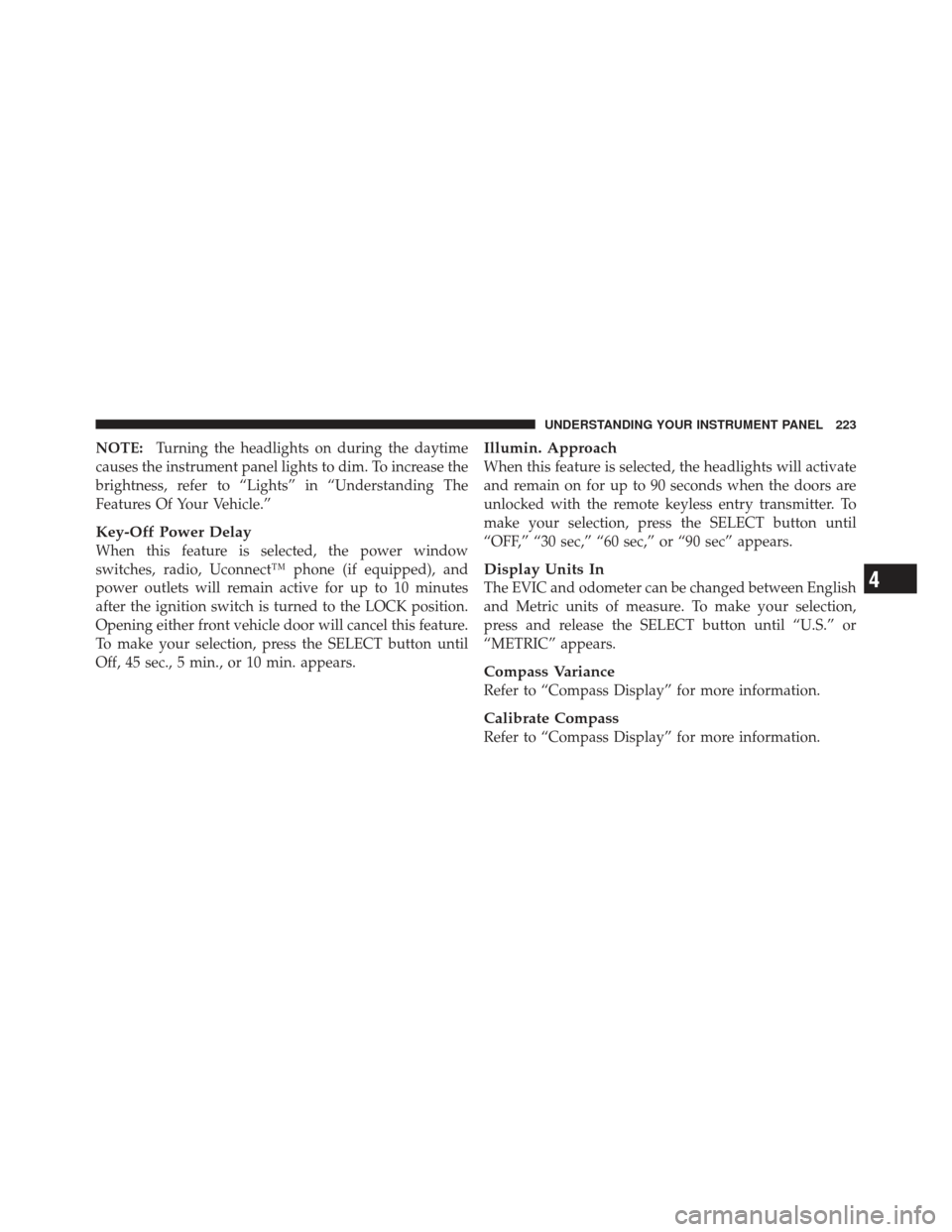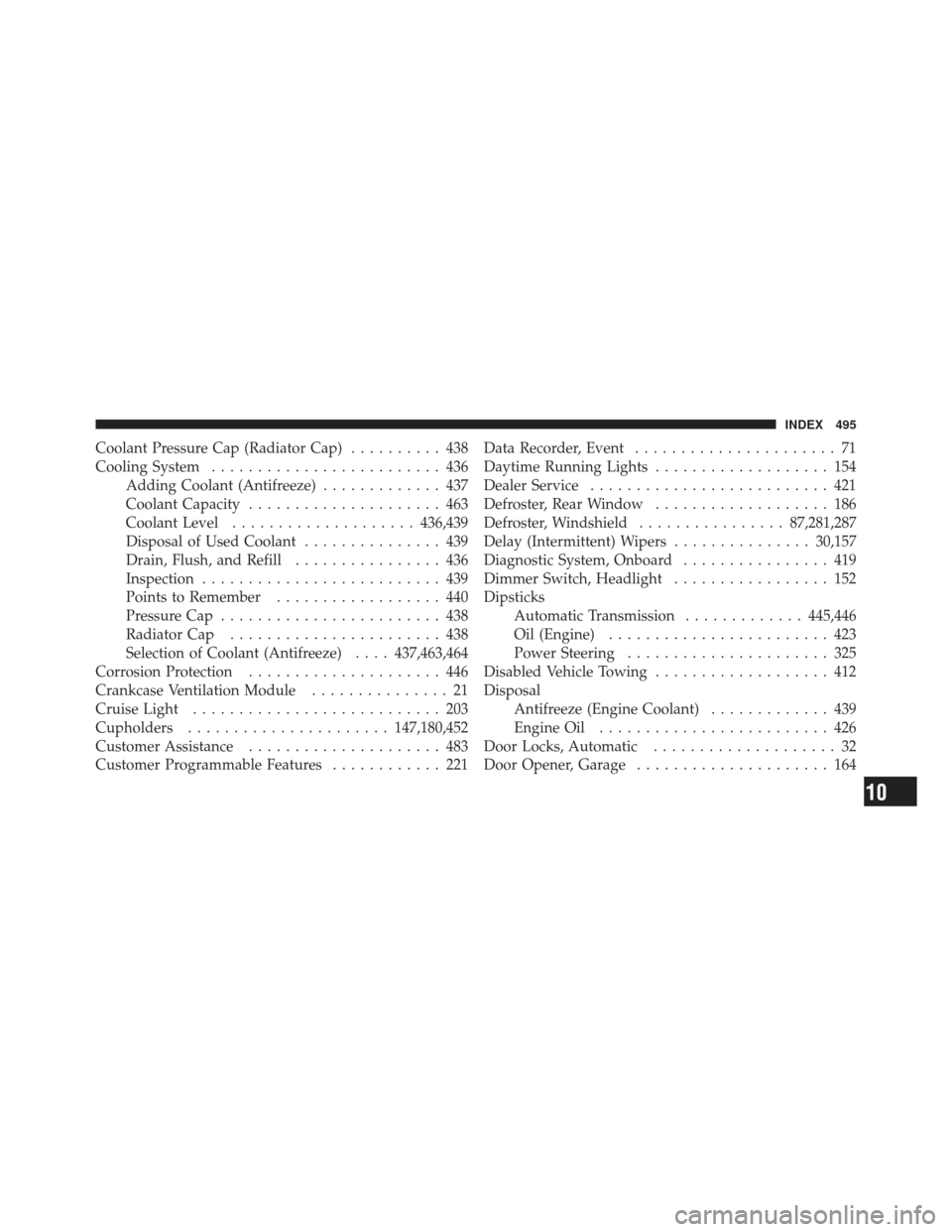Page 225 of 514

NOTE:Turning the headlights on during the daytime
causes the instrument panel lights to dim. To increase the
brightness, refer to “Lights” in “Understanding The
Features Of Your Vehicle.”
Key-Off Power Delay
When this feature is selected, the power window
switches, radio, Uconnect™ phone (if equipped), and
power outlets will remain active for up to 10 minutes
after the ignition switch is turned to the LOCK position.
Opening either front vehicle door will cancel this feature.
To make your selection, press the SELECT button until
Off, 45 sec., 5 min., or 10 min. appears.
Illumin. Approach
When this feature is selected, the headlights will activate
and remain on for up to 90 seconds when the doors are
unlocked with the remote keyless entry transmitter. To
make your selection, press the SELECT button until
“OFF,” “30 sec,” “60 sec,” or “90 sec” appears.
Display Units In
The EVIC and odometer can be changed between English
and Metric units of measure. To make your selection,
press and release the SELECT button until “U.S.” or
“METRIC” appears.
Compass Variance
Refer to “Compass Display” for more information.
Calibrate Compass
Refer to “Compass Display” for more information.
4
UNDERSTANDING YOUR INSTRUMENT PANEL 223
Page 388 of 514

•An electronically actuated trailer brake controller is
required when towing a trailer with electronically
actuated brakes. When towing a trailer equipped with
a hydraulic surge actuated brake system, an electronic
brake controller is not required.
•Trailer brakes are recommended for trailers over
1,000 lbs (450 kg) and required for trailers in excess of
2,000 lbs (907 kg).
CAUTION!
If the trailer weighs more than 1,000 lbs (450 kg)
loaded, it should have its own brakes with adequate
braking capacity. Failure to do this could lead to
accelerated brake lining wear, higher brake pedal
effort, and longer stopping distances.
WARNING!
•Do not connect trailer brakes to your vehicle’s
hydraulic brake lines. It can overload your brake
system and cause it to fail. You might not have
brakes when you need them and could have a
collision.
•Towing any trailer will increase your stopping
distance. When towing, you should allow for ad-
ditional space between your vehicle and the ve-
hicle in front of you. Failure to do so could result
in a collision.
Towing Requirements – Trailer Lights And Wiring
Whenever you pull a trailer, regardless of the trailer size,
stop lights and turn signals on the trailer are required for
motoring safety.
386 STARTING AND OPERATING
Page 389 of 514

Towing Tips
Before setting out on a trip, practice turning, stopping,
and backing the trailer in an area located away from
heavy traffic.
Make sure all trailer and vehicle lights are working
properly — including hazard flashers.
Automatic Transmission
The DRIVE range can be selected when towing. How-
ever, if frequent shifting occurs, select the�3�range (for a
four-speed automatic) or select a lower gear using the
AutoStick� shift control.
NOTE: Using a lower gear while operating the vehicle
under heavy operating conditions, will improve perfor-
mance and extend transmission life by reducing exces-
sive shifting and heat build-up. This action will also
provide better engine braking. If you
REGULARLY TOW a trailer for more than 45 min-
utes of continuous operation, then change the automatic
transmission fluid and filter according to the interval
specified for “police, taxi, fleet, or frequent trailer tow-
ing.” Refer to the “Maintenance Schedule” for the proper
maintenance intervals.
NOTE: Check the four-speed automatic transmission
fluid level before towing. Six-speed transmissions do not
require a fluid level check before towing. If, however, you
notice fluid leakage or transmission malfunction, see
your authorized dealership service center for assistance.
Electronic Speed Control – If Equipped
•
Do not use in hilly terrain or with heavy loads.
•When using the speed control, if you experience speed
drops greater than 10 mph (16 km/h), disengage until
you can get back to cruising speed.
•Use speed control in flat terrain and with light loads to
maximize fuel efficiency.
5
STARTING AND OPERATING 387
Page 451 of 514

Wheel And Wheel Trim Care
•
All wheels and wheel trim, especially aluminum and
chrome plated wheels, should be cleaned regularly
with a mild soap and water to prevent corrosion.
•To remove heavy soil and/or excessive brake dust, use
MOPAR�Wheel Cleaner or equivalent or select a
non-abrasive, non-acidic cleaner.
CAUTION!
Do not use scouring pads, steel wool, a bristle brush,
or metal polishes. Do not use oven cleaner. These
products may damage the wheel’s protective finish.
Avoid automatic car washes that use acidic solutions
or harsh brushes that may damage the wheel’s pro-
tective finish. Only MOPAR� Wheel Cleaner or
equivalent is recommended.
Cleaning Headlights
Your vehicle has plastic headlights that are lighter and
less susceptible to stone breakage than glass headlights.
Plastic is not as scratch resistant as glass and therefore
different lens cleaning procedures must be followed.
To minimize the possibility of scratching the lenses and
reducing light output, avoid wiping with a dry cloth. To
remove road dirt, wash with a mild soap solution fol-
lowed by rinsing.
Do not use abrasive cleaning components, solvents, steel
wool or other aggressive material to clean the lenses.
7
MAINTAINING YOUR VEHICLE 449
Page 456 of 514
CavityCartridge
Fuse Mini Fuse Description
3— 10 Amp
Red Center High
Mounted Stop
Light (CHMSL)/
Brake Switch
4— 10 Amp
Red Ignition Switch
5— 20 Amp
Yellow Trailer Tow – If
Equipped
6— 10 Amp
Red Power Mirror
Switch/Climate
Controls
7— 30 Amp
Green Ignition Off Draw
(IOD) Sense 1
8— 30 Amp
Green Ignition Off Draw
(IOD) Sense 2Cavity
Cartridge
Fuse Mini Fuse Description
9 40 Amp
Green Battery Feed –
Power Seats – If
Equipped
10 — 20 Amp
Yellow Instrument Panel/
Power Locks/
Interior Lights
11 — 15 Amp
Lt Blue Selectable Power
Outlet (Inside Cen-
ter Arm Rest)
12 — — —
13 — 20 Amp
Yellow Ignition/Cigar
Lighter
14 — 10 Amp
Red Instrument Panel
15 40 Amp
Green — Radiator Fan Relay
454 MAINTAINING YOUR VEHICLE
Page 471 of 514

•Change your engine oil more often if you drive your
vehicle off-road for an extended period of time.
•Under no circumstances should oil change intervals
exceed 8,000 miles (13 000 km) or six months, which-
ever comes first.
Your authorized dealer will reset the oil change indicator
message after completing the scheduled oil change. If a
scheduled oil change is performed by someone other
than your authorized dealer, the message can be reset by
referring to the steps described under “Electronic Vehicle
Information Center (EVIC)/Oil Change Required” in
“Understanding Your Instrument Panel” or under “In-
strument Cluster Description/Odometer/Trip Odom-
eter” in “Understanding Your Instrument Panel” for
further information. At Each Stop For Fuel
•Check the engine oil level about five minutes after a
fully warmed engine is shut off. Checking the oil level
while the vehicle is on level ground will improve the
accuracy of the oil level reading. Add oil only when
the level is at or below the ADD or MIN mark.
•Check the windshield washer solvent and add if
required.
Once A Month
•Check tire pressure and look for unusual wear or
damage.
•Inspect the battery and clean and tighten the terminals
as required.
•Check the fluid levels of coolant reservoir, brake
master cylinder, and transmission and add as needed.
•Check all lights and other electrical items for correct
operation.
8
M A I
N T
E
N A
N CE
S
C
H E
D
U L
E
SMAINTENANCE SCHEDULES 469
Page 497 of 514

Coolant Pressure Cap (Radiator Cap).......... 438
Cooling System ......................... 436
Adding Coolant (Antifreeze) ............. 437
Coolant Capacity ..................... 463
Coolant Level .................... 436,439
Disposal of Used Coolant ............... 439
Drain, Flush, and Refill ................ 436
Inspection .......................... 439
Points to Remember .................. 440
Pressure Cap ........................ 438
Radiator Cap ....................... 438
Selection of Coolant (Antifreeze) ....437,463,464
Corrosion Protection ..................... 446
Crankcase Ventilation Module ............... 21
Cruise Light ........................... 203
Cupholders ...................... 147,180,452
Customer Assistance ..................... 483
Customer Programmable Features ............ 221Data Recorder, Event
...................... 71
Daytime Running Lights ................... 154
Dealer Service .......................... 421
Defroster, Rear Window ................... 186
Defroster, Windshield ................87,281,287
Delay (Intermittent) Wipers ...............30,157
Diagnostic System, Onboard ................ 419
Dimmer Switch, Headlight ................. 152
Dipsticks Automatic Transmission .............445,446
Oil (Engine) ........................ 423
Power Steering ...................... 325
Disabled Vehicle Towing ................... 412
Disposal Antifreeze (Engine Coolant) ............. 439
Engine Oil ......................... 426
Door Locks, Automatic .................... 32
Door Opener, Garage ..................... 164
10
INDEX 495
Page 499 of 514

Oil Synthetic........................ 426
Overheating ........................ 392
Starting ........................... 298
Temperature Gauge ................... 196
Engine Oil Viscosity ...................... 425
Enhanced Accident Response Feature .......... 68
Entry System, Illuminated .................. 21
Ethanol ............................... 366
Event Data Recorder ...................... 71
Exhaust Gas Caution ................... 86,369
Exhaust System ....................... 86,433
Extender, Seat Belt ........................ 57
Exterior Lights .......................... 89
Fabric Care ............................ 450
Filler Location Fuel .................... 196,373
Filters Air Cleaner ......................... 427
Air Conditioning .................. 290,430Automatic Transmission
................ 446
Engine Oil ....................... 426,464
Engine Oil Disposal ................... 426
Flash-To-Pass ........................... 153
Flashers .............................. 392
Hazard Warning ..................... 392
Turn Signal ....................... 89,461
Flexible Fuel Vehicles Cruising Range ...................... 372
Engine Oil ......................... 371
Fuel Requirements ................. 369,371
Maintenance ........................ 373
Replacement Parts .................... 372
Starting ........................... 372
Flooded Engine Starting ................... 299
Floor Console .......................... 182
Fluid Capacities ......................... 463
Fluid Leaks ............................. 89
10
INDEX 497